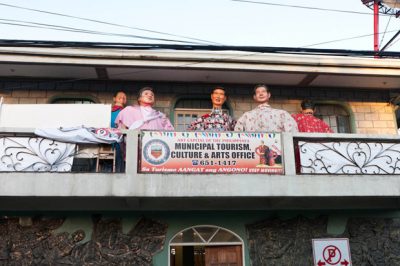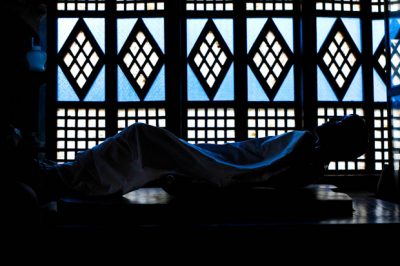Dust, pollution and streets riddled with traffic—Angono, Rizal looks like any other small town near the Metro. In some ways, it’s just that: a small town where locals get around by way of walking and where neighbors are instant friends.
However, Angono sets itself apart with its tradition of vibrant artistry running through daily life—from the town feast down to the nooks and crannies of its streets. Just an hour away from Katipunan by jeepney, Angono is an otherworldly break from the fast-paced urban life.
Art and heritage
In 3,000 BC, the men who lived in the mountains of Angono started engraving images of men and animals on cave walls, creating the Philippines’ oldest existing work of art, the Angono Petroglyphs. Now sited at the Eastridge Golf Club, you can visit this national treasure by driving three kilometers up a steep road and into a hill tunnel.
Since the creation of this prehistoric wonder, art has been handed down in Angono for generations, making art a family matter in this town.
Some of the most prominent families from Angono are artistic ones, such as the Nemirandas, the Blancos and the Vocalans. Each of these families showcases their art through family museums open to the public, displaying the artistic heritage of Angono for the world to see. The Nemirandas give free art lessons as well, while one can sign up for regular classes at the Blanco Academy.
Angono is also home to two National Artists: muralist Carlos “Botong” V. Francisco, the painter of renowned murals, such as Pageant of Commerce, and the discoverer of the petroglyphs, and maestro Lucio San Pedro, the composer of the classic piece “Sa Ugoy ng Duyan” and a former UP College of Music chair and Ateneo band instructor.
“I think the art families are the ones who keep us as the Art Capital [of the Philippines],” says Precious Baltazar (II BS MIS), an Angono native. “They’re the ones giving art camps and continuously spreading artistic enthusiasm in Angono. Our community is proud of [the famous artists who live here], and [we hope] that there are more of [such] artists coming from our town.”
Not everyone in Angono paints, sculpts, composes or cooks. But in Angono, art is something everyone can relate to—as if enjoying art unites the townsfolk in a common identity. “I wasn’t pressured to be artistically inclined,” adds Baltazar. “Every person I have met who lives in Angono was [simply] artistically inclined in one way or another. A lot of people here are interested in the arts simply because it is greatly encouraged in the community.”
Different strokes
Angono expresses its creativity through more than just art in the traditional sense. Visitors of Angono can visit the Balaw-Balaw Restaurant and Art Gallery, which is known for serving exotic food—Adobong Uok (beetle larvae) and Soup No. 5 (involving cow balls and rectum), are popular among those looking for a culinary adventure. For the faint of heart, the restaurant also offers traditional Filipino favorites, such as lechon kawali and halo-halo. The unique Balaw-Balaw dining experience is enriched by the sculptures and soda bottle lanterns hanging from the trees, giving the much-renovated patchwork property the air of an artist’s home.
Inside, Balaw-Balaw is host to the huge art collection of Perdigon Vocalan, the establishment’s founder. The first floor houses paintings and sketches ranging from baskets of fruit to mythical creatures, all produced by Vocalan and his descendants. A spiral staircase leads up to a second floor filled with wood carvings, including an interpretation of the Last Supper and several depictions of the Mother and Child.
Angono also honors its artistic roots with murals along Doña Aurora Street, one trike ride away from Balaw-Balaw. These murals are reproductions of Botong Francisco’s work cast in cement. In a different street corner, another mural salutes Lucio San Pedro. His most famous work, the perennial Filipino lullaby “Sa Ugoy ng Duyan,” is depicted on a wall as a sheet of music where cast metal notes jut out of the cement.
Sculptures and murals are definitely a recurring theme throughout Angono, with a preponderance of mermaids and old men (a reference to “Ang Nuno,” the origin of the town’s name) and even a golden reproduction of the Statue of Liberty adorning the streets. Despite the unavoidable contemporary touches, these works of art show that Angono is a town still very much in touch with its unique heritage.
Tall tales
Before Angono became the Art Capital of the Philippines, it was a Spanish hacienda. The Spanish landlords were concerned with the cost of holding numerous festivals through the course of the year, so instead, they allowed only one: the festival of San Clemente, colloquially known as the Higante Festival. The people of Angono responded by mixing equal parts spectacle and irony to create a singularly unique festival tradition: the Higantes.
Ten to 12 feet in height, the Higantes were originally caricatures of the Spanish landlords. Traditionally positioned upright with their hands on their waists, these paper-mâché men tower over the festivities and boast exaggerated expressions.
Angono’s prominent artistic families build their own Higantes every November to be included in the town procession. It is these larger-than-life Higantes that culminate the multifaceted artistic culture that lives in this little town. “My mom used to watch the festival,” Leandro Kintanar (I BS ES) shares. “It’s a wonderful local festival that highlights the arts and crafts unique to the people of Angono.”
Angono’s homegrown talent has greatly influenced Philippine art, a fact that isn’t surprising when one sees how integral art is to the town’s identity. Despite being a small town, Angono’s expressions of self are huge, much like the Higantes that smile down upon the vibrant lifestyle of the townspeople.
Greener grass
Angono is more than your typical town. A tranquil yet lively painted landscape, it rises early and, come the night, even sleeps. But while its dusty streets appear similar to the Metro’s, Angono’s untouched magic continues to quietly inspire natives and visitors alike.
In time, paint will fade and sculptures will crumble, but Angono’s colorful traditions will never fail to enchant.
- Photo by Ryan Racca
- Photo by Ryan Y. Racca
- Photo by Ryan Y. Racca
- Photo by Ryan Y. Racca
- Photo by Ryan Y. Racca
- Photo by Ryan Y. Racca
- Photo by Ryan Y. Racca
- Photo by Ryan Y. Racca
- Photo by Ryan Y. Racca
- Photo by Ryan Y. Racca
- Photo by Ryan Y. Racca
- Photo by Ryan Y. Racca
- Photo by Ryan Y. Racca
- Photo by Abram P. Barrameda
- Photo by Abram P. Barrameda
- Photo by Abram P. Barrameda
- Photo by Abram P. Barrameda
- Photo by Abram P. Barrameda
- Photo by Abram P. Barrameda
- Photo by Abram P. Barrameda
- Photo by Abram P. Barrameda
- Photo by Abram P. Barrameda
- Photo by Abram P. Barrameda
- Photo by Abram P. Barrameda
- Photo by Abram P. Barrameda
- Photo by Abram P. Barrameda
- Photo by Abram P. Barrameda
- Photo by Ryan Y. Racca





































